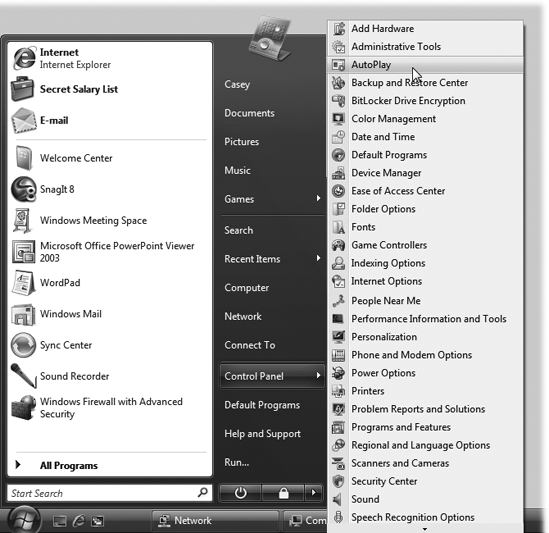Windows Vista comes with no printed user guide at all. To learn about the thousands of pieces of software that make up this operating system, you’re supposed to read the online help screens.
Unfortunately, as you’ll quickly discover, these help screens are tersely written, offer very little technical depth, and lack examples. You can’t even mark your place, underline, or read them in the bathroom.
The purpose of this book, then, is to serve as the startup manual that should have accompanied Windows Vista. In these pages, you’ll find step-by-step instructions for using almost every important Windows feature.
This book is divided into seven parts, each containing several chapters:
▸ Part 1, The Vista Desktop, covers everything you see on the screen when you turn on a Windows Vista computer: icons, windows, menus, scroll bars, the Recycle Bin, shortcuts, the Start menu, shortcut menus, and so on. It also covers the juicy new system-wide, instantaneous Search feature.
▸ Part 2, The Pieces of Vista, is dedicated to the proposition that an operating system is little more than a launch pad for programs. Chapter 6 describes how to work with programs and documents in Windows—launch them, switch among them, swap data between them, use them to create and open files, and so on—and how to use the new micro-programs called gadgets.
This part also offers an item-by-item discussion of the individual software nuggets that make up this operating system. These include not just the items in your Control Panel, but also the most important free programs that Microsoft threw in: Windows Media Player, Photo Gallery, Movie Maker, and so on.
▸ Part 3, Vista Online, covers all the special Internet-related features of Windows, including setting up your Internet account, Windows Mail (for email), Internet Explorer 7 (for Web browsing), and so on. Chapter 8 also covers Vista’s Internet fortification features: the firewall, anti-spyware software, parental controls, and on and on.
▸ Part 4, Beyond the Basics, describes the operating system’s relationship with equipment you can attach to your PC—scanners, cameras, disks, printers, and so on. It also explores Vista’s greatly beefed-up backup and troubleshooting tools.
▸ Part 5, The Vista Network, is for the millions of households and offices that contain more than one PC. These chapters show you how to build your own network. File sharing, accounts and passwords are here, too.
At the end of the book, three appendixes provide a guide to installing this operating system, the “Where’d It Go?” Dictionary, which lists every feature Microsoft moved or deleted on the way to Windows Vista, and a master list keyboard shortcuts in Vista.
Throughout this book, and throughout the Missing Manual series, you’ll find sentences like this: “Open the Start→Computer→Local Disk (C:)→Windows folder.” That’s shorthand for a much longer instruction that directs you to open three nested icons in sequence, like this: “Click the Start menu to open it. Click Computer in the Start menu. Inside the Computer window is a disk labeled Local Disk (C:); double-click it to open it. Inside that window is yet another icon called Windows. Double-click to open it, too.”
Similarly, this kind of arrow shorthand helps to simplify the business of choosing commands in menus, as shown in Figure I-1.
Figure 1. In this book, arrow notations help to simplify folder and menu instructions. For example, “Choose Start→Control Panel→AutoPlay” is a more compact way of saying, “Click the Start button. When the Start menu opens, point to Control Panel; without clicking, now slide to the right onto AutoPlay,” as shown here.
Get Windows Vista Annoyances now with the O’Reilly learning platform.
O’Reilly members experience books, live events, courses curated by job role, and more from O’Reilly and nearly 200 top publishers.


